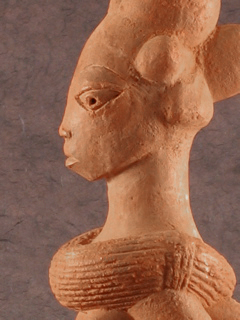5.4: Nok (700 BCE – 300 BCE)
- Page ID
- 31760
The Nok culture emerged around 700 BCE in Western Africa, located in the current day Nigeria, vanishing around 300 BCE. The Nok was one of the most advanced cultures in the sub-Saharan area to fabricate life-sized terracotta figures (5.18). Many of the sculptures have not survived the environment or have been broken, shattered by other people, or looted by treasure hunters. The surviving human statues are very stylized, yet the animal figurines are very realistic, both exhibiting elaborate structures and decorations. Many of the terracotta figures discovered during mining excavations in Nigeria and further excavations found iron smelters located in the same place as the figures, dating to the same era. The Nok were also early makers of iron tools, iron was found in nearby rocks, and by crushing and heating the rock, the iron melted and was used to form tools and art.

Researchers believe the Noks constructed the sculptures using the coil method, the clay from the alluvial river mud consisting of coarse grain, very abundant in the area the Nok lived. They made life-sized human heads and bodies in unusual positions and with a significant amount of adornment (5.19). After the statues were almost dry, the figures were covered with slip and then burnished to create a smooth, glossy surface. All of the figures are hollow and had additional openings, possibly to allow the work to dry or for metal jewelry as a decoration. Covering the pieces with leaves, twigs, and logs, and then setting fire to burn for several hours, hardened the terra cotta statues.


Researchers have found that the figures always had large heads and almond-shaped eyes complete with openings for the eyes, mouth, and nose, presenting a natural appearance (5.20). Many of the figures posed inactive positions, dancing with rattles, figures in a row with ropes around their waists and necks, or someone playing a drum and singing. Although we do not know why they made the figures or what they used the figures for, they came in multiple sizes ranging in size from 2cm to life-size.


